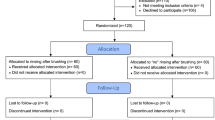Abstract
The aim of the study was to assess salivary fluoride concentrations and ingestion of fluorides after five different techniques of topical fluoride treatment. Ten volunteers received applications of fluoride gel, toothpaste, and foam. Fluoride concentrations were determined using ion-selective fluoride electrode in the samples of unstimulated saliva before and after procedures. The amounts of fluoride applied, recovered from the mouth, and retained in the mouth were calculated for each treatment. It was proved that fluoride ingestion following tray application of fluoride foam was significantly lower than ingestion following tray applications of fluoride gel (p < 0.01). The use of limited amounts of fluorides on a tray resulted in similar fluoride retention and lower ingestion comparing to the method which involves a large portion of fluorides followed by rinsing. Tooth brushing resulted in high salivary retention rates per amount of fluorides used in the procedure. These data provide initial concept about the possible advantages of some methods of topical fluoride application over others.
Similar content being viewed by others
References
Centers for Disease Control and Prevention (2001) Recommendations for using fluoride to prevent and control dental caries in the United States. MMWR 50:1–42
Ogaard B, Seppa L, Rolla G (1994) Professional topical fluoride applications clinical efficacy and mechanism of action. Adv Dent Res 8:190–201
Fejerskov O, Ekstrand J, Burt BA (1996) Fluoride in dentistry, 2nd edn. Munksgaard, Copenhagen, pp 311–327
Hellwig E, Lennon AM (2004) Systemic versus topical fluoride. Caries Res 38:258–262
Marinho VCC (2008) Evidence-based effectiveness of topical fluorides. Adv Dent Res 20:3–7
Oliveby A, Ekstrand J, Lagerlof F (1987) Effect of salivary flow rate on salivary fluoride clearance after use of a fluoride-containing chewing gum. Caries Res 21:393–401
Zero DT, Raubertas RF, Fu J et al (1992) Fluoride concentrations in plaque, whole saliva, and ductal saliva after application of home-use topical fluorides. J Dent Res 71:1768–1775
Sjögren K (2001) How to improve oral fluoride retention? Caries Res 35(suppl 1):14–17
Heath K, Singh V, Logan R et al (2001) Analysis of fluoride levels retained intraorally or ingested following routine clinical applications of topical fluoride products. Aust Den J 46:24–31
LeCompte EJ (1987) Clinical application of topical fluoride products—risks, benefits, and recommendations. J Dent Res 66:1066–1071
Akiniwa K (1997) Re-examination of acute toxicity of fluoride. Fluoride 30:89–104
Whitford GM (1987) Fluoride in dental products—safety considerations. J Dent Res 66:1056–1060
Ekstrand J, Koch G (1980) Systemic fluoride absorption following fluoride gel application. J Dent Res 59:1067
Dawes C, Weatherell JA (1990) Kinetics of fluoride in the oral fluids. J Dent Res 69:638–644
Seppa L, Salmenkivi S, Hausen H (1997) Salivary fluoride concentration in adults after different fluoride procedures. Acta Odontol Scand 55:84–87
Zero DT, Raubertas RF, Pedersen AM et al (1992) Fluorides studies of fluoride retention by oral soft tissues after the application of home-use topical. J Dent Res 71:1546–1552
Duckworth RM, Morgan SN (1991) Oral fluoride retention after use of fluoride dentifrice. Caries Res 25:123–129
Kula K, Kula T, Davidson W et al (1987) Pharmacological of an intra-oral fluoride-releasing device in adolescents. J Dent Res 66:1538–1542
Opydo-Szymaczek J, Borysewicz-Lewicka M, Opydo J (2007) A method for the assessment of fluoride exposure during prophylactic fluoride gel application. Polish J Environ Stud 16:402–405
Borysewicz-Lewicka M, Opydo-Szymaczek J, Opydo J (2007) Fluoride ingestion after brushing with a gel containing a high concentration of fluoride. Biol Trace Elem Res 120:114–120
LeCompte EJ, Whitford GM (1987) Pharmacokinetics of fluoride from APF gel and fluoride tablets in children. J Dent Res 61:469–472
LeCompte EJ, Doyle TE (1985) Effects of suctioning devices on oral fluoride retention. J Am Dent Assoc 110:357–360
Wei SH, Chik FF (1990) Fluoride retention following topical fluoride foam and gel application. Pediatr Dent 12:368–374
Issa AI, Tumba KJ (2004) Oral fluoride retention in saliva following toothbrushing with child and adult dentifrices with and without water rinsing. Caries Res 38:15–19
Whitford GM, Allmann DW, Shahed AR (1987) topical fluorides: effects on physiologic and biochemical processes. J Dent Res 66:1072–1078
Institute of Medicine (1997) Dietary reference intakes for calcium, phosphorus, magnesium, vitamin D, and fluoride. National Academy, Washington, DC, pp 288–313
Opydo-Szymaczek J, Borysewicz-Lewicka M (2006) Variations in concentration of fluoride in blood plasma of pregnant women and their possible consequences for amelogenesis in a fetus. Homo 57:295–307
Duckworth RM, Morgan SN, Gilbert RJ (1992) Oral fluoride measurements for estimation of the anti-caries efficacy of fluoride treatments. J Dent Res 71:836–840
Heijnsbroek M, Gerardu VAM, Buijs MJ et al (2006) Increased salivary fluoride concentrations after post-brush fluoride rinsing not reflected in dental plaque. Caries Res 40:444–448
Author information
Authors and Affiliations
Corresponding author
Rights and permissions
About this article
Cite this article
Opydo-Szymaczek, J., Opydo, J. Salivary Fluoride Concentrations and Fluoride Ingestion Following Application of Preparations Containing High Concentration of Fluoride. Biol Trace Elem Res 137, 159–167 (2010). https://doi.org/10.1007/s12011-009-8575-7
Received:
Accepted:
Published:
Issue Date:
DOI: https://doi.org/10.1007/s12011-009-8575-7




